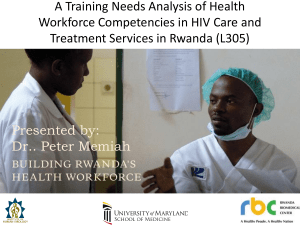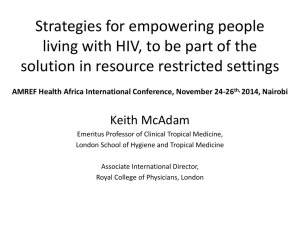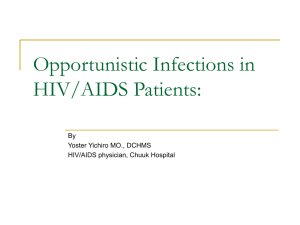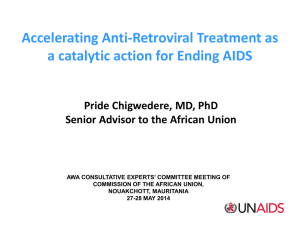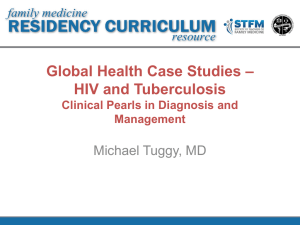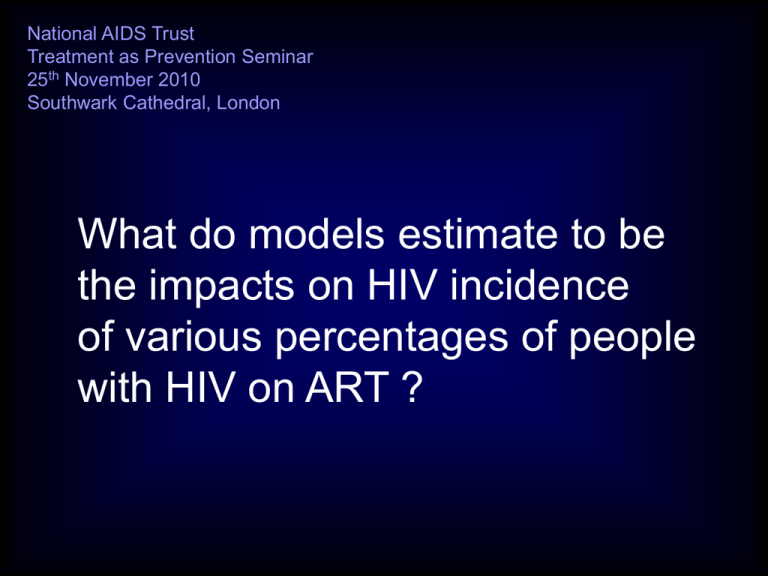
National AIDS Trust
Treatment as Prevention Seminar
25th November 2010
Southwark Cathedral, London
What do models estimate to be
the impacts on HIV incidence
of various percentages of people
with HIV on ART ?
Policy of initiation of treatment at CD4 counts
> 350 may require cost justification
Death rate ~ 5.2 per 1000 person years
If early ART reduces risk by 50% =>
risk reduction 2.6 / 1000 person years
1 death averted per 385 person years of ART
- Will initiation of ART in people with CD4 count > 350 / 500
be funded ?
- Assessment of cost-effectiveness requires a model that
takes account of reductions in incidence
Study group on Death Rates at High CD4 count in ART naïve people. Lancet 2010
Association between number on HAART and
new HIV diagnoses
Montaner et al, Lancet 2010
Association between mean “community” viral
load and new HIV infections
Das et al, PLOS One 2010
High rates of HIV testing but rising incidence in
gay men in Australia
~ 90% of gay men have been tested for HIV
Wand et al, 2010, Prestage et al, 2008
1980
2000
2020
2040
Granich et al, Lancet 2008
Models of the impact of ART on transmission
ART can function as an effective prevention tool, even with high
levels of drug resistance and risky sex
Velasco-Hernandez JX, Gershengorn HB, Blower SM. Lancet Inf Dis 2002
The use of treatment as prevention has the potential to reduce
HIV epidemics only if consistent condom use is maintained.
Wilson et al, Lancet 2008
ART is predicted to have individual and public health benefits
...but the benefit can be lost by residual infectivity or …… sexual
disinhibition...
Abbas UL, Anderson RM, Mellors JW. JAIDS 2006
ART cannot be seen as a direct transmission prevention measure,
regardless of the degree of coverage
Baggaley RF, Garnett GP, Ferguson NM. PLoS Med 2006
Expansion of HAART (amongst those with CD4 < 200 / < 350) led
to substantial reductions in the growth of the HIV epidemic and
related costs
Lima et al JID 2008
Predicted effects on HIV incidence depend on
assumptions on:
- Testing coverage and frequency
- Effect on individual health of early ART
- Feasibility of identifying people in primary infection
- Durability of adherence / viral load suppression on ART
- Development and transmission of drug resistant virus
- Change in unprotected sex due to HIV diagnosis
- Change in unprotected sex due to viral suppression
- Extent of reduction in infectivity with ART
HIV synthesis model
Creates a ‘dataset’ of the course of infection and therapy for
individual simulated patients.
Years from infection
0
0.25
0.5
0.75
1.00
Fixed variables
at infection
Variables updated
over time
Calendar date
Age at infection
Gender
Primary resistance
Calendar date
Age
Viral load
CD4 count
Risk of AIDS / death
Use of specific ARVs
Resistance mutations
1.25
HIV progression in absence of ART
Viral load
CD4 count
AIDS
Age
PCP
prophylaxis
Death from HIV
Gender
Death from
other cause
Phillips et al, HIV Medicine 2007; Lancet 2008
Assumed 1.5fold increased
Effect of ART
Current
adherence
Time on
current
regimen
Acquisition of
new resistance
mutations
CD4 counts
CD4 count
# Active drugs
in regimen
Viral load
Death
from HIV*
AIDS*
Switch to
next line
of ART
*influenced by age and PCP prophylaxis also
Phillips et al, HIV Medicine 2007, Lancet 2008
Failure
of current line
of ART
Effect of stopping ART
Time off ART
CD4 counts
CD4 count
Loss from
majority virus of
acquired resistance
mutations
Viral load
Death
From HIV*
AIDS*
Probability of
resuming ART
*influenced by age and PCP prophylaxis also
Phillips et al, HIV Medicine 2007, Lancet 2008
Other processes include:
- Loss to follow-up
- Substitution of drugs due to toxicity
Fit to observed data
Observed
Modelled
46%
~ 40
40%
48%
35
45%
Virologic failure by 7 years
27%
29%
>1 resistance mutation by 7 yrs
19%
25%
Rate of viral rebound in those with < 50 cps/mL
>1 resistance mutation to 3 classes by 6 yrs
Mean CD4 count increase at 3 years
3-6% per yr
4%
273
6% per yr
6%
270
Natural history
AIDS by 10 years
Median CD4 count at diagnosis of AIDS
% dead by 1 year from initial AIDS
Effect of ART
Phillips et al, HIV Medicine 2007
HIV transmission synthesis model:
Heterosexual epidemic in southern Africa
Creates a ‘dataset’ of the lifetime experiences of ~50,000 people in a
population, aged over 15.
Years from 1985
1985
1985.25
1985.5
1985.75
Additional variables updated over time
e.g.
Calendar date
Infection with HIV
Sexual risk behaviour:
- Long term partnership status
- Number of new partners
1986.00
1986.25
Risk of HIV infection in uninfected subject
Subject
Number of new
partnerships formed
by HIV+ people
Concurrent
HIV+
population
Current viral
load of infected
partner
Number of
new partners
Number of new
partners who are
HIV+
Age
Gender
Probability of
HIV infection
Long term
partner HIV+
Long
term partnership
status
Incidence and prevalence
of HIV in people with
long term partnerships
Risk of infection
also depends on current STI
Comments
- In southern African heterosexual epidemic setting:
Assuming that unprotected sex with long term
partners will reduce upon HIV diagnosis, a
policy of frequent testing is likely to be beneficial
for incidence, regardless of whether ART initiation
threshold is CD4 200, CD4 350 or higher.
- Plans to adapt this model for MSM in UK
Conclusion
Models so far have demonstrated that intensive HIV
testing with early ART initiation can, in principle,
lead to substantial reductions in incidence if certain
conditions hold.
Models required now are ones that will give as
realistic and detailed assessment as possible of the
predicted impact of frequent testing and early ART
on HIV incidence, and thus enable estimation of
cost-effectiveness of the approach.
Acknowledgements
Valentina Cambiano
Geoff Garnett
Deenan Pillay
Marco Vitoria
Diane Bennett
Deenan Pillay
Jens Lundgren
Current funding from National Institute for Health Research
Programme Grant

